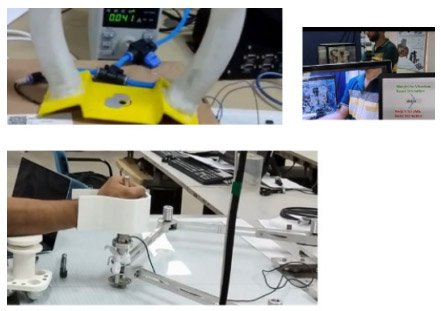Institute:
CSIR CMERI Durgapur
PI Name:
Dr. Soumen Sen
Technology Readiness Level (TRL)
4
The project addresses the lack of impedance regulation
in current collaborative robots and assistive devices.
While Cobots can follow human-guided motion, they
struggle with safe force modulation during physical
interaction. Existing exoskeletons often use bulky or
inefficient actuators. High-pressure PAMs are unsuitable
for mobile, wearable applications. Additionally, most
systems fail to detect and interpret both motion and
impedance intent from the user.

| Actuators: Variable Impedance actuators (motor based and soft pneumatic muscle actuators) |
|---|
| Sensors: EMG sensors and Multi-axes Force/Torque sensors |
| Controllers: Motion and Impedance Controllers using ML-based software |
| Soft Materials: Hyperelastic silicone (Polysiloxane) for soft, safe actuation |
| Prototyping Tools: 3D Printer and Precision Moulds for actuator fabrication |

MZ-122, IIT Delhi, Hauz Khas, New Delhi-110016 India
IHFC, Block – A, Research & Innovation Park, IIT Delhi, Hauz Khas, New Delhi – 110016
07AAFCI6629H1ZE
Designed & Developed by eClerx
© Copyright IHFC 2025 All Rights Reserved.
At Alphoenix Design Pvt. Ltd. We provide custom design and development of high-efficiency BLDC motors for different sectors like EVs, Aviation and Drones, Industrial machinery and Household appliances.
We’ve designed our motors in such a way that its manufacturing process would reduce material waste of motors by 70% and increase efficiency by 5-8%. Our flagship motors provide an efficiency of around 92%-95%. The motor will be manufactured with the capability to utilize CRGO (Cold-Rolled Grain-Oriented) material in its construction.
Our radial flux motors can provide such efficiency with easy manufacturing processes. Utilizing our new motor makes it feasible to achieve an efficiency rating exceeding 95%.
Founded by Marico, Parachute Kalpavriksha Foundation’s objective is to make a difference in the life of Indian farmers. The word “Kalpavriksha” is derived from Devanagari script “Kalpa” (imagination/wish) and “Vriksha” (Tree), meaning the tree that fulfils your wishes. We are a Non-Profit organization working towards the welfare of farmers in India. Currently we have enrolled more than 65,000 farmers covering almost 2.75 Lakh acres of plantation across the states of: Tamil Nadu, Karnataka, Kerala and Andhra Pradesh.
Our team of 100+ Agronomists regularly pay visits to the farmers and educate them on scientific farming practices and help them increase their productivity. Apart from our Productivity improvement program, we provide other services like Agri Expert on phone, Agri Business Centers (ABC), Water conservation activities by construction of farm pond, classroom training to farmers through Kalpavriksha Knowledge Centre etc.